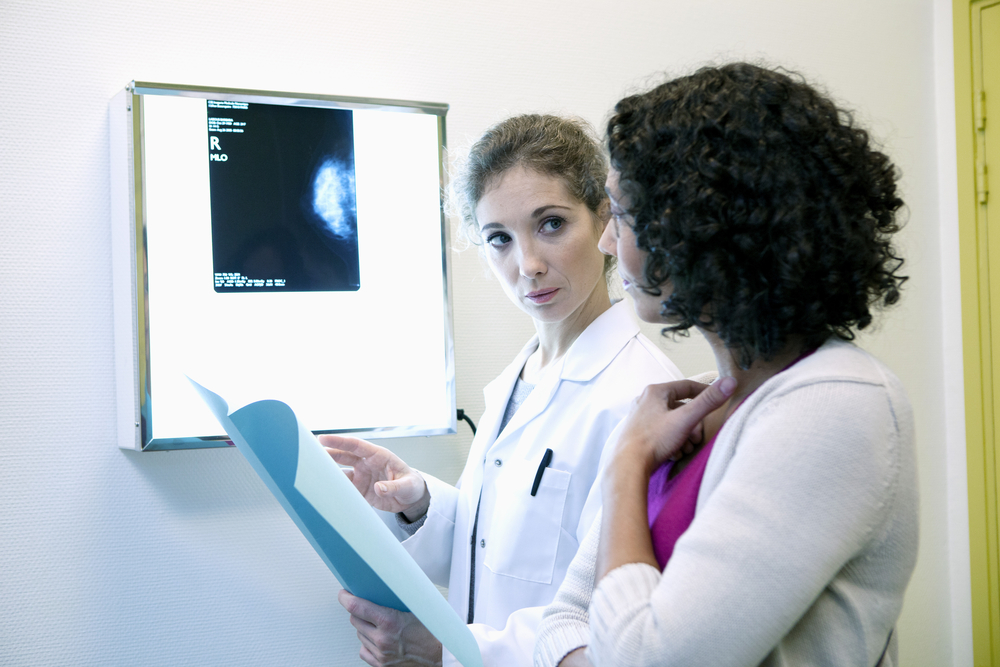
Screening and Diagnosis of Breast Cancer
Breast cancer may not present with any recognizable signs or symptoms until later in development. This could be due to having a small lump that can’t be felt, or not developing noticeable changes within the breast or body that would be indicative of cancer. All these reasons are why it is important to follow mammogram screening and self-breast exam guidelines.
Guidelines
- Breast self-examination: This is a screening technique used by women to self-examine their breasts for any unusual lumps by performing circular motions around the breast starting at the nipple and working to the base of the breast. This screening should be performed by women once a month, preferably not while in the period.
- Mammograms should be performed starting at age 45-50 and continue bi-annually (once every 2 years) until the age of 74. Some women may need to have mammogram screening at a younger age due to family history of breast cancer, but this decision should be taken with the advice of your medical provider.
- Medical breast exam: should be performed yearly by your medical provider
Breast cancer may be detected by physical, or self-examination, but needs to be confirmed using one of the following methods:
Mammogram
The most common method for screening and diagnosing breast cancer is mammogram.It is used to detect, identify, or examine breast lumps. A mammogram is performed by a machine that uses x-rays to identify breast lumps that may be too small to feel. Many images are taken from multiple views to provide the doctor with a full image of the breast tissue in order to better identify small breast lumps. Dense breasts can reduce the efficiency of the mammogram as fibrous tissue can resemble small breast lumps.
Ultrasound
If a lump has been identified through a mammogram or breast self-exam, an ultrasound of the breast might be requested. Ultrasound uses sound waves read by a computer to create an image of the breast. The image created by an ultrasound is called a sonogram. This method allows for the identification and classification of the lump as either a solid mass or a fluid filled cyst. Generally cysts are not cancerous, as cancerous tissue usually presents itself as a solid mass.
MRI
Although less common, a diagnostic MRI can be used to generate clearer images of the breast tissue and lump. This exam works by shooting magnetic energy throughout the breast tissue, which then can be read by a computer and a medical professional to examine lumps within the breast tissue.
Biopsy
In most cases, once a mass or lump has been identified the medical provider will run a biopsy on the tissue to determine if it is cancerous. These tests remove tissue or fluid from a mass and examine it under a microscope to identify if it contains cancerous cells. Biopsy is the only definitive test to diagnose breast cancer. There are three types of biopsies performed: fine-needle aspiration, core-needle biopsy, and surgical biopsy.
The goal of each of the three biopsy tests is to identify if cancerous cells are present within the suspicious lump or tissue. Therefore, once the cells have been collected they are sent to a pathologist for examination and report. If no cancer-cells are found then the report will classify the lump as benign, or non-cancerous. However, if cancerous cells are identified, the report will list further important information including the growth rate or grade of the cancer. For surgical biopsies, further information can be given regarding the margin around the abnormal tissue. A positive margin indicates that the cancer has spread beyond the abnormal lump tissue, while a negative margin means that there are distinct lines between the cancerous and noncancerous tissue.
Fine-needle aspiration
Fine-needle aspiration is performed when the identified lump is filled with fluid. In this procedure a needle is used to puncture the mass and remove any fluid that resides within. Generally, it is common for the mass to collapse as the fluid is removed. However, if the mass doesn’t collapse, this procedure can still be used to remove the solid cells for further examination.
Core needle biopsy
A core needle biopsy removes a small portion of solid tissue from the breast by using a hollowed (or “core”) needle. For this procedure the breast is placed under local anesthesia, or “numbed”, as the needle is guided into the mass to remove the tissue. Generally the physician performing the biopsy will be guided to the proper mass location through the use of an ultrasound.
Surgical biopsy
The third biopsy option is a surgical biopsy, also known as a lumpectomy. For this procedure, the patient is given an IV and other medications to calm them and prevent any pain, while a surgeon removes a portion of the lump. If feasible, the surgeon will attempt to remove the entire mass. Usually, a portion of the surrounding normal tissue called the “margin” is removed as well.




